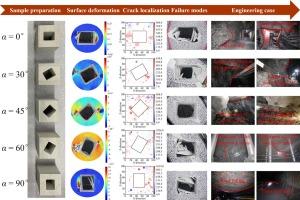Asymmetric deformation and failure behavior of roadway subjected to different principal stress based on biaxial tests
IF 7.4
1区 工程技术
Q1 CONSTRUCTION & BUILDING TECHNOLOGY
引用次数: 0
Abstract
The magnitude and direction of stress will affect the failure of roadway. The impact of stress magnitude and direction on roadway failure was investigated using a rock failure system equipped with true triaxial loading, acoustic emission (AE), and digital image correlation (DIC) technologies. The system allowed for the simulation of rock sample failures under various three-dimensional stress conditions, while real-time monitoring was conducted using a high-precision microseismic system. By prefabricating rectangular holes at different angles in sandstone specimens, roadways under different stress effects in engineering can be simulated. Biaxial loading tests were then performed on these prefabricated sandstone cube specimens to observe external fracture characteristics and internal fracture information using acoustic emission equipment. The peak strength of samples with holes is approximately 38–56% of that of intact samples. In the early and middle loading stages, the strain on the surface is on the order of 10-3. In the later loading stage, the strain on the surface is on the order of 10-2. The findings indicate that roadway failure primarily involves local particle ejection, fragment spalling, large-scale particle ejection, plate crack buckling, and eventual failure. The ultimate failure mode varies based on stress deflection angles: with no included angle, the roadway exhibits a ’V’ shaped failure zone on both sides, predominantly experiencing tensile failure. At included angles of 30°, 45°, and 60° between stress and roadway axis, the roadway displays a “—” failure pattern along the diagonal, characterized by a combination of tension and shear failure. The extension angle of the“—” failure zone varies depending on the stress deflection angle. At a 90° included angle, the roadway shows a ’V’ shaped failure in the roof and floor, primarily undergoing tensile failure. Real-time monitoring of the strain field evolution around the roadway during failure using DIC method revealed valuable insights. AE events at different deflection angles reflect the progression of micro cracks in the specimen, showing a strong correlation with macro failure. The research outcomes elucidate the mechanisms behind various forms of roadway failure induced by stress deflection and shed light on the failure mechanism at different stress deflection angles.

基于双轴试验的受不同主应力作用的路面非对称变形和破坏行为
应力的大小和方向会影响巷道的破坏。利用配备了真正三轴加载、声发射(AE)和数字图像相关(DIC)技术的岩石破坏系统,研究了应力大小和方向对路面破坏的影响。该系统可模拟各种三维应力条件下的岩样破坏,同时使用高精度微震系统进行实时监测。通过在砂岩试样上预制不同角度的矩形孔,可以模拟工程中不同应力效应下的路面。然后对这些预制砂岩立方体试样进行双轴加载试验,利用声发射设备观察外部断裂特征和内部断裂信息。带孔样品的峰值强度约为完整样品的 38-56%。在加载初期和中期,表面应变约为 10-3。在后期加载阶段,表面应变约为 10-2。研究结果表明,路面破坏主要包括局部颗粒喷射、碎片剥落、大面积颗粒喷射、板裂纹屈曲和最终破坏。最终的破坏模式因应力偏转角度的不同而不同:在没有包含角度的情况下,路面两侧呈现 "V "形破坏区,主要经历拉伸破坏。当应力与路面轴线的夹角分别为 30°、45° 和 60°时,路面沿对角线呈现"-"型破坏模式,其特点是拉伸和剪切破坏相结合。"-"型破坏区的延伸角随应力偏转角的变化而变化。在包括 90° 角时,巷道的顶板和底板出现 "V "形破坏,主要是拉伸破坏。使用 DIC 方法实时监测巷道周围应变场在破坏过程中的演变,揭示了有价值的见解。不同挠度角度下的 AE 事件反映了试样中微小裂缝的发展过程,与宏观破坏密切相关。研究成果阐明了应力偏转诱发的各种路面破坏形式背后的机理,并揭示了不同应力偏转角度下的破坏机理。
本文章由计算机程序翻译,如有差异,请以英文原文为准。
求助全文
约1分钟内获得全文
求助全文
来源期刊

Tunnelling and Underground Space Technology
工程技术-工程:土木
CiteScore
11.90
自引率
18.80%
发文量
454
审稿时长
10.8 months
期刊介绍:
Tunnelling and Underground Space Technology is an international journal which publishes authoritative articles encompassing the development of innovative uses of underground space and the results of high quality research into improved, more cost-effective techniques for the planning, geo-investigation, design, construction, operation and maintenance of underground and earth-sheltered structures. The journal provides an effective vehicle for the improved worldwide exchange of information on developments in underground technology - and the experience gained from its use - and is strongly committed to publishing papers on the interdisciplinary aspects of creating, planning, and regulating underground space.
 求助内容:
求助内容: 应助结果提醒方式:
应助结果提醒方式:


